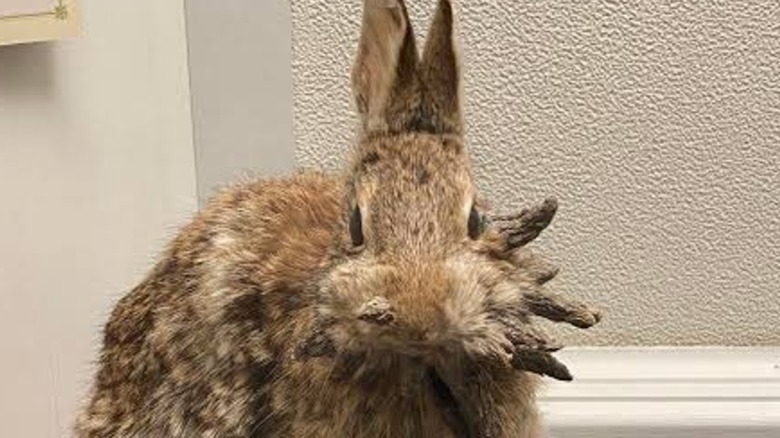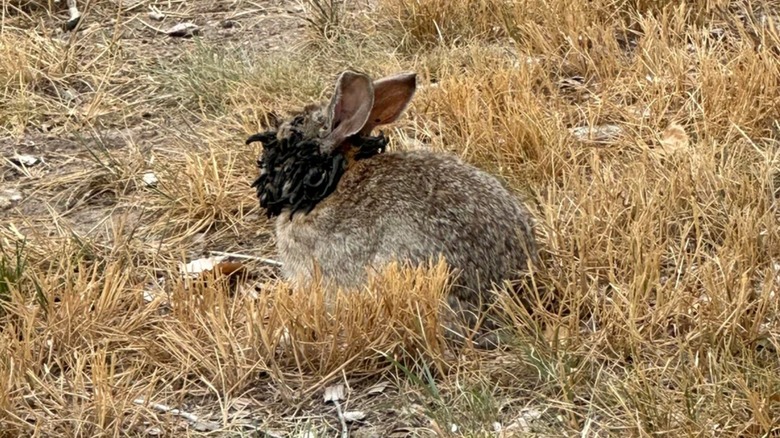What's Going On With Colorado's 'Frankenstein' Rabbits? Fact Is Weirder Than Fiction
When the temperature rises in the summer months, things can turn a little bit strange. The heat makes people behave more wildly, and summer also typically sees the publication of weirder news stories than usual, as outlets look to fill the space caused by political recesses and quieter news cycles overall. In the U.K. the period is known as "silly season," a phrase which has been used in relation to the media there since the 1860s. In 2016, it was the "Killer Clown" phenomenon, in 2020, it was the reported arrival of strange metal monoliths in Utah and other neighboring states. And in the summer of 2025, it was a disturbing story about strange-looking rabbits spotted in Colorado.
As reported by 9NEWS, many residents of Fort Collins had begun to notice the town's wild rabbit population beginning to take on a bizarre new look, with blackish growths resembling quills, horns, or tentacles emerging from their faces (via YouTube). Images of the rabbits were posted on Reddit, and quickly went viral as Redditors began to speculate on what was happening to the rabbits. Some users compared the disturbing sight to the creature Cthulhu, H. P. Lovecraft's terrifying tentacle-faced entity. "No Eldritch rabbits please," read one comment, a word often used by fans to describe Lovecraftian horror. Meanwhile, others referenced "The Last of Us," which features zombies rife with bizarre growths all over their bodies.
But despite the pictures of the rabbits having some horrifying associations, the truth is that their strange affliction is caused by a virus. Thankfully, it is no real cause for concern, despite the worry it caused among locals, internet users, and the media referring to the afflicted creatures as "Zombie" and "Frankenstein" rabbits.
The virus causing growths on the faces of rabbits
Experts have had no trouble identifying what has caused the strange mutations in Colorado's cottontail rabbits. Rather than quills, horns, or tentacles, the growths are actually wart-like tumors made of keratin — the organic material that makes hair and nails in humans – caused by the Shope papillomavirus. As well as the face, the growths can appear on an infected rabbit's neck and body. The virus is spread through the rabbits getting bitten by insects such as ticks.
Shope papillomavirus takes its name from Dr. Richard E. Shope, who discovered the virus in the 1930s. However, the virus itself isn't anything new. Experts have pointed to traditional folk tales such as the Jackalope myth that have described rabbits with horns or antlers as evidence that everyday people had noticed the strange growths on the animals generations ago, long before the papillomavirus was understood.
Does the virus affect humans?
Thankfully, there is no evidence that the Shope papillomavirus can transmit to humans, or even to other animal species (regardless, the public has been warned not to allow domestic pets to come into contact with wild animals such as cottontail rabbits). The disease can, however, transmit to domestic pet rabbits, and owners should contact a veterinarian if they suspect their pet is beginning to show signs of developing the growths associated with it, as the symptoms can be more severe among domestic rabbits than the wild population.
While humans can't be infested by Shope papillomavirus, human papillomavirus does exist. Better known as HPV, it is extremely common, with most people contracting it at some point during their lifetime. There are more than 100 different strains, which generally infect the skin, though it is symptomless in most cases. HPV is sexually transmitted, with certain strains affecting the mouth, throat, and genitals, causing them to develop warts. While the disease typically leaves one's system after a period of a few years, HPV is also linked to increased cancer risk. While there is no cure for HPV, vaccines are available.
Can the rabbits be cured?
Unfortunately, there is no effective remedy for Shope papillomavirus affecting the cottontail rabbits in Colorado and elsewhere. But despite the virus having worrying visual effects on infected rabbits, the truth is that rabbits can live with Shope papillomavirus. The growths are painless, and, in most cases, remain harmless, eventually disappearing from the infected rabbit's body once the virus leaves them. As one Colorado resident told 9NEWS, they spotted an infected rabbit with "horns" one year, and it returned a year later, having made it through the winter in seemingly in good health, only its growths had become noticeable larger during that time.
However, as with human HPV, there is an increased cancer risk amongst sufferers, especially among domestic rabbits. It is only in such cases that cancer develops that veterinarians will euthanize affected rabbits, or if the growths caused by the virus cause the animal suffering by interfering with its ability to eat, drink, or breathe.



